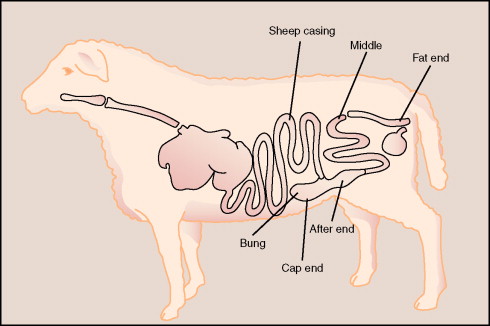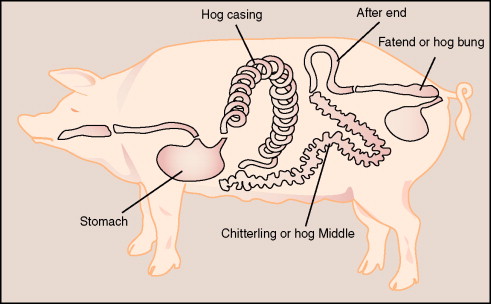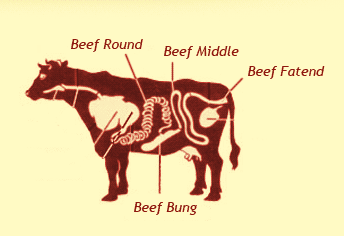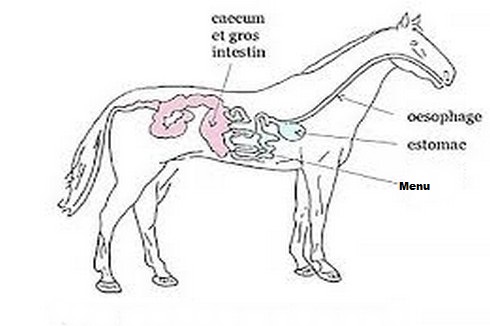Sausages are stuffed using nozzles on which the casings are "mounted".
Most household mincers or food processors have:
- *Either a single nozzle (usually Ø 20 or 22mm)
If this is your case, you will only be able to make large sausages like Toulouse (or larger) using pork casings from calibre (Ø) 30/32 or higher.
- *Or multiple nozzles
Generally, these mincers come with two nozzles.
One for making large sausages (see above) and another smaller one for chipolatas/merguez.
Prefer calibre 24/26 sheep casings (in pots or punnets for very small quantities) because your nozzle is probably conical and starts at 16mm and ends at 18mm.
The ideal is of course to buy a meat stuffer with at least 3 nozzles, the smallest of which will be 10 to 16mm.
Below is a small table of nozzle/casing correspondences for what you will find in the common market.
| Nozzle diameter | Admitted casing caliber |
|---|---|
| 10 to 13mm | 16/18 → 22/24 |
| 14 to 16mm | 22/24 → 28/30 |
| 18 to 20mm | 30/32 → 34/36 |
| 30 to 32mm | 36/38 → 40/42 |
| 36 to 38mm | 42/+ |
And as always, if you need any help, don't hesitate to contact us.
Have a nice day,
The Boss
For optimal preservation, casings should be salted, then drained well (24 to 48 hours depending on the type of casing) and then placed back in saturated brine.
Making a saturated brine is very simple:
- A saturated brine is a brine in which the salt no longer dissolves.
- This generally corresponds to 250g of ordinary salt / litre of water.
Tip:
To test the saturation of your brine, take a raw, washed potato.
- Plunge it into the brine, the potato should float freely; if it is a little "in between", it means that there is not enough salt.
- You must therefore continue to add salt.
- Let your brine stand for 1/4 hour before testing it.
EXCEPTION:
- After sprinkling with salt, casings on pipes or soft tubes should not be drained for more than 1/4 hour, otherwise the casing will stick to the plastic tube.
- Then put them in saturated brine.
That's it !
Casing on pipes or soft tubes save a significant amount of time, especially for professionals who make large quantities.
They will also be a relief for those who have trouble untying casings that sometimes get tangled.
How to use them:
Unsalt the piped casing under cold water, then soak them for about twenty minutes in a large volume of warm water.
That's it, they are ready to use!
- For soft tubes (sheep casings 1 hank 90m pots and hog casings):
Slide the soft tube completely onto your nozzle and remove the plastic by pulling backwards on the protruding plastic tab.
- For pipes (sold in buckets of 10 hanks 60m sheep casings):
Remove the colored ring and present the rigid tube in front of the nozzle, then manually move the casing from the plastic tube onto the nozzle.
- If you have any desalted and soaked casing tubes left after making your sausages:
Roll the piped casing generously in salt and let them drain for a MAXIMUM of 10 minutes (otherwise the casings will stick to the plastic tube).
Put them back in full saturated brine.
WARNING! The shelf life of these casing tubes will not exceed 15 days - 3 weeks, even cool stored!
Otherwise, you can always remove the remaining casings from the pipe/tube, re-salt them and let them drain for 24 hours in a colander, but you will have to re-thread them "by hand" on your nozzle during your next production.
Enjoy your sausage making!
To make a good sausage or salami, the type of natural casing and its calibre (diameter) varies relatively depending on the region and country.
However, there are a number of general applications and habits that stand out, particularly in our beautiful French countryside and cities.
We present you an overview of these below:
SHEEP CASINGS
In the small intestine called "sheep casing"
- Sheep casings, tender and delicate casings, are generally used for making small sausages such as chipolatas, merguez, fresh sausages (nature sausages, Indian sausages, vigneronne sausages, burger sausages, etc.), cocktail sausages.
- The choice of calibre is up to you depending on the desired wideness, but generally 20/22 and 22/24 are well suited for merguez, while other sausages will prefer 22/24 or 24/26 (Beware of the diameter of your nozzle).
- 26/28 will be more used in wide fresh sausages such as enrolled sausages, or knacks, Frankfurt sausages, sauerkraut sausages.
- 18/20 will be mainly reserved for small merguez, cocktail sausages or other regional or Asian specialities.
- The large intestine is not used in charcuterie but is still used to produce condoms ( yes, yes, this is true ! )
HOG CASINGS
In the small intestine called "Hog casing"
- With a thicker structure than sheep casings, hog casings are used for larger sausages such as Toulouse sausage, white pudding, black pudding (30/32 to 34/36 depending on the region), narrow hog casings (26/28 and 28/30) will be more popular in the East of France for white sausage, roasting sausage (bratwurst), gendarme etc...
- You can also make small dry sausage or chorizo in 34/36 or 36/40.
Sow casings
- Sow casings are stronger than hog casings and are often used to make dry sausage (perche sausage with large round trips).
- Depending on the desired final diameter, you will use calibres 38/40 to 45/+, the drying time will be proportional.
In the large intestine
- The large intestine is called "Chitterling" and is often used to make dry sausage (hence the convolutions of the casing) but also more particularly to make country pudding (meat pudding), Landes pudding.
- The chitterling is also the main constituent ("the meat") with the stomach, of andouillette and andouille.
- The afterend (smooth part between the fatend and the chitterling) is mainly used for andouillette and morteau sausage.
- Some people use it to make dry sausage but, in our opinion, it is not the most suitable casing.
- The fatend (the final part of the large intestine) is used in the manufacture of the rosette de Lyon, the fuseau lorrain or the liver sausage.
- the hog bung (appendix of the pig), are mainly used in the manufacture of mountain sausage (Jésus), coppa, mouchettes or bardin bags (specialty of the Forez region).
BEEF CASINGS
In the small intestine called "beef round" ( curved form casing)
- The narrow calibres 34/37 and 37/40 are used for the manufacture of black pudding, Creole pudding and certain andouillettes (in Cambrai in particular).
- Some regions also use these calibres to make pure beef dry sausages.
- 40/43 and 43/46, intermediate calibres, will be used more for cooked sausages such as garlic sausage, horse sausage, Paris Ail,
- 46/+ will be used for the same applications, but the sausage will, of course, be larger.
In the large intestine called "beef middle" (straight form casing)
- The beef middle is distinguished from the beef round by its straight and cylindrical shape, its tissue is among the strongest of the casings, especially in 1st choice (Quality IA) as proposed by CEBONAT®.
- We recommend its use in the manufacture of dry sausage because it is a more stable casing over time than the chitterling which is likely to rancid and is stronger than the latter.
- The choice of calibre (from 50/55 to 60/+) is up to you depending on the wideness of the final product you want.
- The 50/55 or 55/60 is mainly used.
- The beef middle is also used in all the manufacture of straight cooked sausages (garlic sausages, Lyon sausages, cervelas etc...)
-
Finally, the beef bung (appendix of the beef, called also " cap" when cut) will be mainly used to make coppa, andouillette or Danish salami
HORSE CASINGS
- Only the small intestine of the horse is used in charcuterie.
- The tissue of the horse casing is even more resistant and thicker than that of beef casings.
- Its calibres 50/55 - 55/60 - 60/65 -65/70-70/75 -75/+ or 80/+ are mainly used in the manufacture of andouilles.
- It's up to you to choose the size!
-
That's it, we've told you everything! Don't hesitate to add to the list of products made with casings in your regions by contacting us directly.








